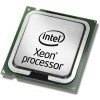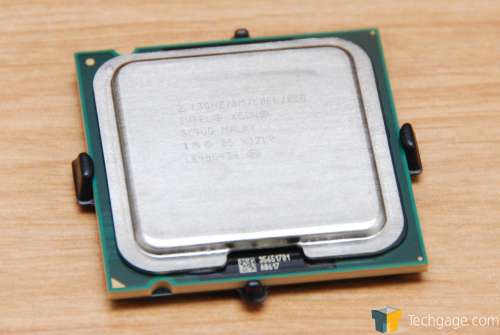- Qualcomm Launches Snapdragon 4 Gen 2 Mobile Platform
- AMD Launches Ryzen PRO 7000 Series Mobile & Desktop Platform
- Intel Launches Sleek Single-Slot Arc Pro A60 Workstation Graphics Card
- NVIDIA Announces Latest Ada Lovelace Additions: GeForce RTX 4060 Ti & RTX 4060
- Maxon Redshift With AMD Radeon GPU Rendering Support Now Available
Intel Xeon X3210 2.13GHz Quad-Core B3-Revision

One of the most popular CPUs on the market right now is the Q6600, thanks to the fact that it offers four cores at 2.4GHz. But what about the Xeon’s? Their prices are also more affordable now, with their X3210 2.13GHz retailing for $260. Read on as we pit this Quad-Core against the rest of our fleet.
Page 1 – Introduction
With last months launch of Intel’s 6×50 series of processors also came price drops that everyone had been anticipating for months. Rumors were that you would be able to purchase a Quad-Core for close to $300, and to everyone’s relief, it proved absolutely true. However, while most will run towards the Q6600, many will overlook the Xeon alternatives. While not normally clocked the same, they had price drops as well, and should not be ignored.
One of the more popular Xeon’s that were noticed was the X3210, a Quad-Core clocked at 2.13GHz. While the clock speed leaves a bit to be desired for desktop users, it was hard to ignore the $250 price tag. This was at a time when Q6600s retailed for $280 – $300, so a small frequency drop could save you upwards of $30.
But, to say ‘less expensive’ almost seems silly. Just last year, an E6600 cost close to $400, while a Q6600 today retails for $300 or lower. It’s a great time to be building a new computer, there’s no doubt about that.
After last months price drops though, prices have fluctuated constantly. One day, the Q6600 might retail for $280 from your favorite e-tailer and then the next, you’ll find it for $350. So needless to say, if you spot the CPU on the cheap, it’s probably not the best idea to sit back and wait, if you want to secure it for the lowest price possible.
At the time of writing, US e-tailers are selling the Q6600 2.4GHz Quad-Core for an average price of $280.00, while the X3210 sits at closer to $260. At that point, if big overclocking is in the cards, then the Q6600 is well worth the extra $20, unless you happen to find a X3210 G0 revision. Ahh, revision hunting.
When Intel released G0 revision processors, it was a good day for enthusiasts. Every model seemed to overclock far beyond what was possible with previous revisions, so it’s important to keep an eye out if overclocking is important to you. This is where things get tricky, however. If you are purchasing a processor from a random e-tailer, chances are good that it’s a luck of the draw. However, you might be lucky enough to visit an e-tailer that will list the entire spec number.
If the X3210 spec ends with SLACU, you know that it’s a G0 revision. If it’s SL9UQ, it’s a B3, which is what we have on the test-bench today. On the Q6600 side of things, G0 revisions will end with SLACR, while B3 ends with SL9UM. So, if you can manage to snag a G0 revision, you will not be disappointed. If you don’t have a choice and end up with a B3, hope should not be lost, as they are still amazing performers.
For those wondering if Xeon processors are better in other ways over standard desktop chips, the answer is yes, but it might not mean much to you in the long run. Xeon processors are the cream of Intel’s crop, so they go through a more stringent testing process to make sure they are perfect for server use. Aside from that, you could overclock a Xeon and Core 2 Quad to the same clock speeds and performance would be equaled.
That all said, the processor we are taking a look at today, once again, is the Xeon X3210, clocked at 2.13GHz with a TDP of 105W and will run stable at 1.100v – 1.372v, depending on your motherboard and luck. Like it’s desktop counter-parts, this CPU also features a 1066FSB with 8MB total L2 cache.
This review will not be as full-featured as our usual offerings, since this product has been out for quite a while, and there aren’t any surprises since it’s mainly a speed change from the normal Core 2 Quads. Also, a lot of text is borrowed from our previous CPU reviews since it applies here as well. With that said, let’s jump straight into our testing methodology.
Support our efforts! With ad revenue at an all-time low for written websites, we're relying more than ever on reader support to help us continue putting so much effort into this type of content. You can support us by becoming a Patron, or by using our Amazon shopping affiliate links listed through our articles. Thanks for your support!






